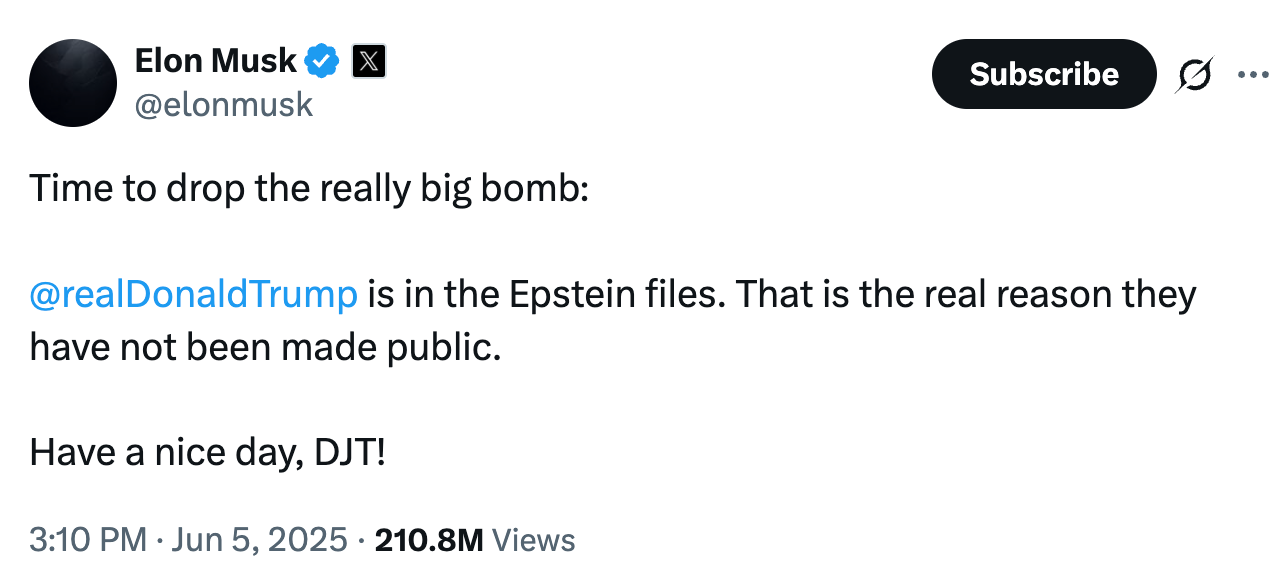ARTICLE AD BOX
Elon Musk’s X profile is like a window into his psyche: an inescapable stream of consciousness where impulsive tweets reveal his unfiltered thoughts and shifting moods.
Musk harnessed his social media platform to propel Donald Trump to the White House, feeding anti-Democrat content and election conspiracy theories to his followers. Now Musk is turning that same platform – home to nearly 600 million monthly users – against him.
After posting earlier in the week that Trump’s signature budget policy was a “disgusting abomination” that will “drive America into debt slavery”, the billionaire is openly taunting Trump on X, even calling for his impeachment.
An analysis of Musk’s tweets by The Independent shows that Musk has undergone a dramatic shift in both the tone and volume of his posts since his initial support of Trump in mid-2024 to when he began distancing himself from his governmental duties earlier this year – weeks before the White House announced his Washington tenure had finished.
And now the platform has chronicled the rise and fall of the world’s most powerful bromance.

Musk began tweeting incessantly after he publicly endorsed Trump in July last year following the first attempt on the president’s life in Butler, Pennsylvania.
Then, once Musk was tapped in November to lead the Department of Government Efficiency, he emerged as Trump’s tweeter-in-chief.
Despite his new White House commitments, not to mention running six companies – including SpaceX, Tesla, and X itself – Musk appeared more glued to his keyboard than ever, using the platform as his primary news source, and place to share his views and stir up controversy.
The first 50 days of the Trump administration arguably marked Musk’s most fervent display of support for the president, both in terms of tweet content and frequency.
On February 7, he mused that, “I love @realDonaldTrump as much as a straight man can love another man.”
Take President’s Day, February 17, his most prolific 24-hour posting spell to date.

Musk posted 262 times, according to The Independent’s analysis, with messages ranging from single emojis to lengthy missives attacking Democrats.
All told, the posting spree equated to one message every five-and-a-half minutes, with no breaks.
Musk had a busy Q1 — between January 20 and March 10, he posted 6,778 times – averaging more than 135 X posts per day.

And he stayed on message, tweeting about his government-slashing force DOGE more than any other topic in that period, quickly followed by “Trump” and “president.”
Social media analytics firms like Social Blade were forced to stop tracking tweets after X said these businesses had to pay for an Enterprise subscription, at $42,000 to $210,000 a month.
The resulting gap has made transparency on X murkier than ever; and is also why The Independent could only analyze Musk’s posts until mid-March.

In early spring, Musk’s public pledges of MAGA allegiance and trollish squibs began to slow down, and the subjects of his posts moved from Trump administration duties to his own commercial interests.
Buyers of his electric vehicles protested against his shift to right-wing politics and efforts to dismantle federal departments, with Tesla’s stock price plummeting, and a Rome dealership set ablaze.
In April, Musk announced plans to significantly reduce his involvement with DOGE, opting to work remotely and allocate more time to Tesla.
A month later, Musk’s X daily posts at points reached single figures. In hindsight, it might be considered the calm before the storm.
By the end of May, Musk came off the platform to deliver a gut punch to the Trump administration. He told NBC News that Trump’s showpiece tax bill “undermines” the work done by DOGE, without directly mentioning the president.
Musk landed a heavy blow on Tuesday, blasting the president’s “Big, Beautiful Bill” as an “outrageous, pork-filled, disgusting abomination.”
But it was after a press conference with the German Chancellor where Trump said he was “disappointed” with Musk’s comments, that Musk went on his most destructive X rampage yet — calling Trump ungrateful, calling for his impeachment and saying he’s linked to Jeffrey Epstein.

And these claims get read and spread by a wide audience: his Thursday post declaring “Trump would have lost the election” if it weren't for his support garnered nearly 15 million views in a single day.
This is more than just a playground spat between the two rich powerful men, because Musk’s ownership of X allows him to reach a vast audience, some of whom are skeptical of mainstream media, and control a narrative — and his posts have been known to set off market reactions, media cycles, and political waves.
Those who have stuck with X, whether they are one of Musk’s 220 million followers or not, have been inundated with his musings and attacks morning, noon, and night.
Musk is believed to selectively issue suspensions and use algorithms to throttle foes that are critical of both him and his ventures.
According to the tech news site Platformer, the self-styled “free speech absolutist” directed a team of 80 engineers to amplify his own tweets over others, ensuring they reach vast audiences (he allegedly did the same for Trump in November).
Musk has subsequently blurred the line between platform owner, political provocateur and propagandist. How will he next use X to punish the social media-reliant, legacy media-averse president?









 English (US) ·
English (US) ·